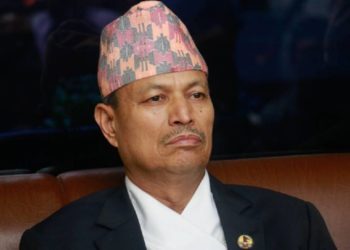KATHMANDU: Economic Digest offers a concise yet comprehensive overview of significant business happenings in Nepal, presented in easily digestible summaries.
Nepal’s economy shows mixed signals as it enters the new year 2082: the stock market surged with increased investor confidence, while foreign direct investment and tax collections from large taxpayers also indicated positive trends.
However, fiscal challenges persist—government spending has far outpaced revenue, capital budget utilization remains low, and public protests continue over unresolved cooperative frauds.
The government is reallocating idle funds, introducing structural reforms such as borrowing limits, and expanding social security coverage.
Meanwhile, sectors like construction and urban property sales are driving revenue and loan growth, and key infrastructure projects, including the Kathmandu–Kerung railway, are progressing steadily amidst broader governance and regulatory scrutiny.
NEPSE Index Rises by 27.14 Points on First Trading Day of 2082
The Nepal Stock Exchange (NEPSE) kicked off the new year 2082 BS with a significant gain, climbing 27.14 points to close at 2,689. At its peak during the session, the index hit 2,704 points at 1:54 PM.
Trading volume also surged, with total turnover reaching NPR 8.54 billion—up from NPR 6.28 billion recorded on the previous trading day. Shares of 212 companies increased in value, while 34 saw declines.
The investment sector led the gains with a 2.71% rise, followed by development banks at 2.46%. Other sectors posted moderate increases: banking (0.48%), finance (1.59%), hotels and tourism (1.99%), hydropower (1.47%), life insurance (0.81%), manufacturing (1.22%), microfinance (0.60%), non-life insurance (1.07%), and the miscellaneous category (0.61%).
Gold price falls by Rs. 1,700 per tola
The price of gold dropped by Rs. 1,700 per tola on Tuesday, with the Federation of Nepal Gold and Silver Dealers’ Association setting the new rate at Rs. 184,300. Just a day earlier, gold had reached a record high of Rs. 186,000 per tola.
Silver prices also saw a decrease, falling by Rs. 15 per tola—from Rs. 1,960 to Rs. 1,945.
Govt expenditure exceeds revenue by Rs. 142 billion in nine months
Government spending surpassed revenue by Rs. 142 billion in the first nine months (Shrawan to Chaitra) of the fiscal year 2024/25, according to the Office of the Auditor General. Revenue collection stood at Rs. 831 billion, far short of the annual target of Rs. 1.419 trillion—achieving only 58%.
During Chaitra alone, the government spent Rs. 159 billion while generating only Rs. 111 billion in revenue. The data also shows that only 29% of the capital budget was utilized, while 59% of recurrent expenses were met.
Govt redirects idle project funds to 58 active initiatives
The government has reallocated budgetary resources from stalled or underperforming projects to 58 active initiatives in the fiscal year 2080/81. According to the Ministry of Finance, Rs. 3.38 billion was transferred in Falgun alone after previously allocated budgets were depleted.
Most reallocations supported infrastructure and urban development under the Ministry of Physical Infrastructure. An additional Rs. 2.38 billion was disbursed for 46 new projects, and Rs. 2.5 million was granted as financial aid. Moreover, 17 new laws and policies with potential fiscal impacts were also approved.
Urban property sales drive land revenue growth
Despite a slight drop in total land and housing transactions, the government collected more revenue from property dealings in the first nine months of FY 2024/25. The Department of Land Management reported 374,171 transactions generating Rs. 33.22 billion in revenue—a 13.81% increase compared to last year.
Chaitra saw the highest monthly collection so far, with 49,832 transactions bringing in Rs. 4.39 billion. Officials credit high-value urban property sales, especially in Kathmandu Valley, for the revenue boost. Lalitpur’s Lagankhel office led in collections, while the eastern Tarai reported the most transactions.
PM Oli stresses agriculture as pillar of human survival
Prime Minister KP Sharma Oli underscored agriculture as the most vital sector for human life during the closing of the South Asian Farmers Federation’s second conference on Tuesday.
“Over 60% of our population depends on agriculture, yet its economic contribution is disproportionately low. It is not just important—it is indispensable, more so than any other business or profession,” he emphasized.
Fiscal Commission proposes borrowing limits for all govt levels
The National Natural Resources and Fiscal Commission (NNRFC) has proposed borrowing ceilings for the federal, provincial, and local governments for the fiscal year 2025/26.
The federal government may borrow up to 5% of projected GDP, while provincial and local units can borrow up to 12% of their total revenues, including fiscal transfers. The commission emphasized borrowing must be limited to development projects with proven long-term economic benefits, backed by cost-benefit analysis and legal procedures—marking a shift from prior informal borrowing practices.
Commission calls for Rs. 10 billion allocation to refund cooperative depositors
The High-Level Economic Reform Recommendation Commission has recommended allocating Rs. 10 billion to refund savings trapped in 22 financially troubled cooperatives.
Despite earlier commitments, the refund process remains unimplemented. The FY 2024/25 budget had pledged refunds up to Rs. 500,000 using collateral from cooperative operators, but no concrete action has followed.
With over Rs. 200 billion owed to the public by more than 500 cooperatives, protests continue. The commission also proposed capping savings transactions and restricting cooperatives’ operations to a single local level to curb misuse and systemic risks. The long-planned National Cooperative Regulatory Authority has yet to be established.
Signs of rising income among high-earning taxpayers
Recent data from the Large Taxpayer Office shows an improvement in the earnings of high-income individuals and businesses, with tax revenues from those with annual transactions exceeding Rs. 1 billion increasing. In Chaitra alone, the office collected Rs. 33 billion—a 22% rise compared to the same month last year.
This growth aligns with key tax collection periods in Poush, Chaitra, and Asar, as taxpayers must settle 40% of estimated taxes in Poush and 30% each in the following two months.
Middlemen have access to PM’s bedroom, alleges Gagan Thapa
Nepali Congress General Secretary Gagan Thapa has made a strong statement, claiming middlemen have infiltrated the country’s highest leadership, even suggesting they have access to the Prime Minister’s bedroom.
Speaking in Kathmandu, Thapa differentiated between legitimate private businesses and exploitative intermediaries, blaming the latter for Nepal’s economic troubles.
Debt ceiling recommendations for FY 2082/83 outlined by NNRFC
The National Natural Resources and Finance Commission has proposed borrowing limits for the next fiscal year: the federal government may borrow up to 5% of projected GDP, while provincial and local bodies can raise loans up to 12% of their combined revenues.
The commission emphasized that such borrowing should fund development projects with long-term returns, not recurring expenses.
Supreme Court blocks new age criteria for Governor appointments
The Supreme Court has temporarily suspended new age-related guidelines for appointments under the Finance Ministry, which would have removed the 30–65 age limit for officials and 35–65 for board members.
The ruling, prompted by a writ filed by two advocates, halts any appointment of a new Nepal Rastra Bank governor under the new rule until further review.
Nepal Rastra Bank rolls out new Rs. 5 notes
The central bank has introduced updated five-rupee notes, retaining the same design and color as previous versions. The notes feature Mount Everest on the left, a rhododendron watermark, the signature of former Governor Mahaprasad Adhikari, and the year 2081 B.S. printed at the bottom.
Govt holds Rs. 11.52 billion in foreign institutional investments
Nepal has invested over Rs. 11.5 billion in shares of international financial institutions, including the World Bank, IMF, ADB, AIIB, SDF, and IBRD. These investments are part of long-standing agreements with global and regional institutions.
NEA says power outages not due to load-shedding
The Nepal Electricity Authority clarified that recent power disruptions were caused by weather conditions and not due to load-shedding.
The NEA criticized misleading social media claims and assured that efforts are ongoing to restore supply in affected areas.
FDI commitments near Rs. 58 billion this fiscal year
Foreign investment commitments reached Rs. 57.97 billion between Shrawan and Chaitra of the current fiscal year—an increase of Rs. 27.86 billion compared to the same period last year, according to the Department of Industry.
Construction sector gets most loans so far in FY 2081/82
The construction sector has received the largest share of loans—9.5%—from financial institutions, amounting to Rs. 19.78 billion. The majority has gone toward housing and infrastructure projects such as bridges and highways.
SpiceJet, Air India Express to resume and expand flights to Nepal
SpiceJet is resuming daily flights between Delhi and Kathmandu starting Baisakh 27, reentering Nepal’s airspace after six years. Air India Express will also begin services from Bangalore to Kathmandu from Asar 17, joining Nepal Airlines on that route.
Contract and temporary govt workers now covered by Social Security Scheme
As of the new year 2082, temporary and contract staff working in government-affiliated bodies can now join the Social Security Fund. Their contributions will be based on a minimum of 60% of their basic pay.
Supreme Court orders shutdown of brick kilns in Panchkhal
The Supreme Court has ordered an interim halt to brick kiln operations in Panchkhal Municipality following a five-year legal battle. The court responded to local residents’ complaints about health and environmental damages.
Compensation fixed for Budhigandaki Project-affected locals
Sahas Urja, in collaboration with local officials, has set compensation rates for land affected by the Budhigandaki Hydropower Project. Land in settlement areas is valued at Rs. 300,000–400,000 per aana, while land outside these areas is valued at Rs. 150,000 per aana.
Kathmandu–Kerung Railway geological study nears completion
The geological assessment for the proposed Kathmandu–Kerung railway is nearly done. Soil and rock samples have been collected from 75 of 80 targeted locations across Kathmandu, Nuwakot, and Rasuwa.
Narayanghat–Butwal road to close at night for expansion work
To speed up work on the Narayanghat–Butwal section of the East-West Highway, the road at Daunne will be closed nightly from 11 PM to 5 AM until Baisakh 15.
Microfinance victims threaten bigger protests
Victims of microfinance institutions have warned of stronger protests, citing government inaction despite 40 months of peaceful demonstrations. At a Kathmandu press conference, they criticized the authorities for using force instead of addressing their concerns.









Comment